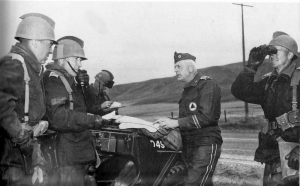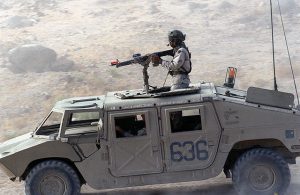The Many OPFOR Nations
The asymmetric OPFOR has been haunting the training grounds of the US Army for seventy years now, beginning shortly after World War II. Having an inherently dissimilar force is effective at training an army to face an opponent that looks, moves, and fights differently. OPFORs have run the gamut from overly broad to overly detailed. This post is a partial history of the twisting and turning nature of this training “heel”, to use the pro wrestling term.
The Circle Trigons
The first dissimilar OPFOR nation came in the form of “Aggressor”. While the name of the nation was unimaginative, everything else was not. An elaborate backstory of the nation and its ruling Circle Trigon Party being bankrolled by both the Western Allies and Soviets out of the rubble of World War II, only to emerge as a monstrous powerhouse on its own, capable of subverting the populace and launching repeated invasions of the continental US. In addition to Trigon doctrine, their manuals went into detail describing pay scales and retirement benefits (!)
The Aggressors spoke Esperanto, had differently colored uniforms with distinct ranks, and, most notably, a bizarre crested helmet.
Circle Trigon equipment was broadly similar to that of the US, but its doctrine was understandably more Soviet. It contained examples as aiming for flexibility at higher levels of command and assigning assets to match and having air forces be assigned to “Air armies” under the control of the overall ground commander. One interesting note is that while it shifted to become increasingly Russian in terms of names (a multi-division unit was called an ‘army’ by the 1960 manual instead of the American designation of ‘corps’), its highest field unit remained the “Army Group” instead of the more directly accurate “Front”.
Given their nature as army publications, the Circle Trigon manuals are relatively vague on the nature of the Aggressor Navy. They do say it exists and includes carriers (a far cry from the small, low-priority Soviet Navy in the immediate postwar period), but don’t describe it with the same detail. This is an oversight and opportunity for a scenario designer like me. Because realistically (to the extent that anything about their background can be called realistic), the fight to keep the naval supply lines open would overshadow the ground campaign.
One final note about the Circle Trigons, that was a flaw in their actual execution, but a benefit for Command designers. There were few examples of visual modifications on vehicles, and thus Aggressors entered ‘battle’ with American equipment that had triangles painted on the side. Thus my dilemma between the “actors” and “characters” is solved-it’s American units with Esperanto designations.
Cold War OPFOR
For the rest of the Cold War, the OPFORs adopted a far more sedate background than the crazed pulp tone of the Circle Trigon. Far more directly Soviet-based, with the common name “Krasnovia”, from Russian Krasny-(red), and with more effort to show visual modifications, they performed effectively.
Regrettably, this does not spark my imagination as much. Oh, I can and have gladly done exercise scens in that period. It’s just covered heavily already, and I think it’s telling that there I prefer the “actor” to the “character” by, ironically enough, making the action symmetric with US equipment on both sides.
Modern Developments
My original post on the opposing forces was on two manuals released in the early 1990s. The Heavy OPFOR remained a thinly-veiled Russia from the “Front” down, while the Light OPFOR was a lower-level force representing an ex-Soviet client. Roughly a decade later, subsequent publicly available manuals have broadened the scope by doing the following.
- Separating equipment from organization. Whereas the early 1990s manuals had a pretty clear “Heavy OPFOR gets 120+mm tanks and Light OPFOR gets 115-mm” distinction, the modern guides contain multiple tiers, with everything from gizmoed up modern tanks to T-34s, both fitting in the similarly organized division.
- Technological updates. Not just being more dispersed in light of better surveillance and an ever-faster kill chain, but talking about the importance of social media. Information and psychological warfare, barely mentioned in the earlier manual, has huge segments devoted to it.
- Increased flexibility. The small-unit doctrine is no longer quite as detailed, and given the nature of the 2000s, irregular and ‘hybrid’ forces are given greater focus.
With a bipolar environment giving way to an increasingly complex one, the ‘building-block’ approach that enables everything from a minor irregular nuisance threat to a peer war has been effective. One training set demonstrated this by creating a range of countries from “Donovia”, the heir to Krasnovnia and regional top dog to the authoritarian sometimes ally/sometimes foe “Atropia”. Other regions around the world can be similarly made should the need arise.
Besides their direct scenario function, the OPFOR guides have been fairly useful for me in terms of seeing the (on-paper) composition of a certain unit. Stuff like what organic air defense assets a particular something has is particularly useful.
My collection of public domain OPFOR manuals has been made available here




